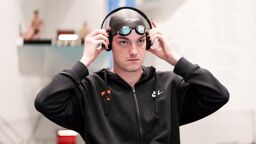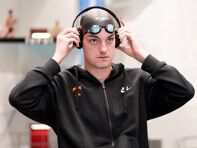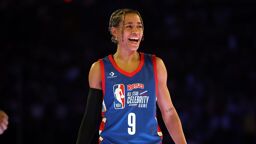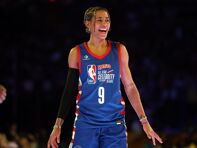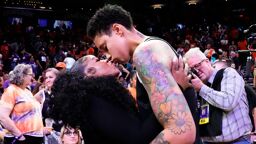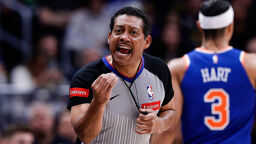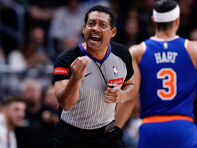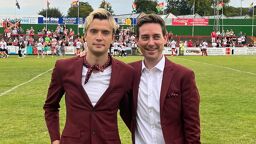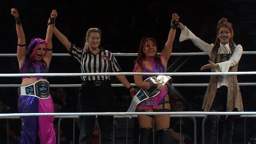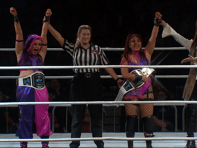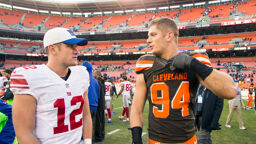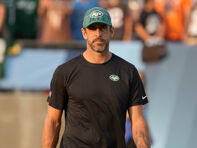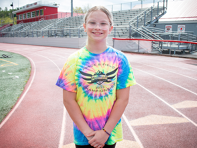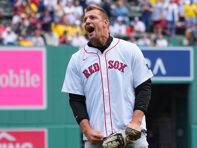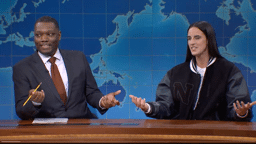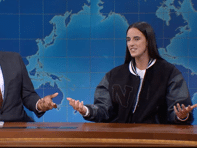A book takes a look at how sports are driving perceptions about gender roles for men. This chapter deals with two mainstream athletes — Jason Sehorn and Freddie Ljungberg — who became successful underwear models.
By David Coad
From "The Metrosexual: Gender, Sexuality, and Sport"
Copyright SUNY Press
The initiative of using athletes in order to exploit their virility and heterosexuality has been the cornerstone of men’s underwear publicity in the United States since the days of Jim Palmer. This is particularly obvious in the career of Gregory Sovell. After working for Calvin Klein, Sovell started a new men’s underwear label in 1991 called 2(x)ist (“to exist”). From the start, this line was directed at what was perceived to be a “gay market.” A publicity campaign from 1994 used professional model Tracy James, an American who had worked for at least sixteen underwear companies including Emporio Armani Underwear. He was chosen for a Cosmopolitan centerfold in 1996. Advertisements of James relied on a pumped up, Muscle Mary body with an angelic head, traits believed to attract a homosexual audience. One black and white photograph of James wearing white briefs shows the model characteristically lying on a bed, his head thrown back on a pillow. Armpits, deltoids, six-pack, and imposing thighs all invite the homoerotic gaze.
 |
| Jason Sehorn |
Toward the end of 2001, Sovell’s company attempted to widen their customer base by selling their boxers and briefs to heterosexual males. In order to attract non-gay male buyers, 2(x)ist butched up its undies act by choosing a new spokesman from the world of football. This had temporarily worked when eight football players were chosen by Jockey in the late 1970s and was confirmed with [Mark] Gastineau, [Joe] Namath, and [Boomer] Esiason in the 1980s.
The services of New York Giants cornerback Jason Sehorn were bought for a million dollars. Jeff Danzer, executive vice president of marketing for 2(x)ist, explained the move away from a professional male model to a football player. He stated that “In order to get the word about us out to the masses, we had to go with someone everybody could identify with. Every guy wants to be him, and every woman wants him.”
Asked about Sehorn’s appeal to gay men, Danzer nonchalantly added “so be it” The blatant homoeroticism of previous 2(x)ist iconography was downplayed in the photographs and publicity shots of the Giants’ star player. Photographs of Sehorn standing, sitting, and reclining in white briefs and boxers, avoided raunchiness. Instead, they tastefully showed a jock at ease in designer underwear. While this publicity was aimed simultaneously at two distinct targets, women and heterosexual males, it was obvious that Sehorn would also hold appeal with homosexual males.
There was an added reason to use a twice-married, heteronormative sportsman to sponsor men’s underwear. In order to attract heterosexually identified males or their partners into buying more sexy, costly, and stylish underwear, it made commercial sense to have a married man exhibit himself in a Lycra piqué knit, brushed nylon, or Peruvian cotton. Without this strategy, buying underwear for luxurious softness, moisture management systems, stretch, and “breathability” might be construed as fetishistic and thus resemble homosexual shopping habits. Sponsorship of “Queer Eye for the Straight Guy” by 2(x)ist, coupled with explicit advice from the Fab Five mentioning the underwear stylist in various episodes, showed the new inseparability of the heterosexual and gay buying public, now rubbing shoulders at the same underwear counters.
Like his predecessor, Jim Palmer, Sehorn’s preoccupation with the body extended far beyond men’s underwear to include a general interest in the sartorial. Sehorn’s reciprocal relationship with the world of fashion, his exposure in the men’s style press and his attendance at public events in New York have all helped to publicize metrosexuality. Public interest in Sehorn as a style jock began in September 1999 when GQ (U.S.) ran “Jason Sehorn Is Born” with the subtitle “The hard-bodied cornerback and soft-to-the-touch cashmere make a comeback this season.” Wearing a kind of wool that Carson Kressley from Queer Eye once described as “pornographically pleasurable to the touch,” Sehorn modeled for six photographs, wearing expensive garments made of cashmere. The use of the words “hard” and “soft” in the subtitle was a way to convince male readers that it was possible to be virile and stylish at the same time.
One photograph shows Sehorn proudly exhibiting his six-pack by partially stripping off a Polo Ralph Lauren turtleneck. The nipples and six-pack became an invitation for readers to appreciate, fantasize about, and want to touch the athlete’s body. A close-up full-page portrait of Sehorn’s head may have been there to exhibit a cashmere crewneck, but the center of focus was a man’s face, not his clothes. There was some obvious titillation proffered to readers who might be male or female, straight or gay.
Sehorn has multiplied public appearances in New York and in Beverly Hills as well since his retirement from professional football. After attending the Armani Retrospective at the Guggenheim in October 2000, he was present at the launch party of the Lanvin fragrance Oxygene Homme in February 2001. Demonstrating his personal engagement with the fashion industry, he was seen onstage at the 2001 and 2002 Vogue Fashion Awards in New York City. In April 2003, Sehorn attended the Metropolitan Museum of Art Costume Institute Benefit Gala, sponsored by Gucci, and in February 2004 the model was photographed at the Louis Vuitton 150th Anniversary party and store opening during Olympia Fashion week. In February 2006, Sehorn attended the 8th Annual Costume Designers Guild Awards in Beverly Hills. He typifies how attributing importance to underwear can be a small piece in a larger picture concerning body image and self-care. Sehorn’s potential effect on changing perceptions linked to looking after the body tended to be restricted to the United States. When a non-American underwear model working for Calvin Klein stole the limelight in 2003 at the height of media interest in metrosexuality, the sphere of influence of one athlete standing in his briefs extended to the world.
Undie Trouble
 |
| Freddie Ljungberg |
The Jason Sehorn underwear campaign took place before metrosexuality was brought to the attention of the world media. This is why the football player’s name was not immediately associated with the cultural trend known as metrosexuality.
I would now like to consider Fredrik Ljungberg, an underwear model who presents two major differences from Sehorn. First, as a bachelor, Ljungberg does not benefit from the same amount of heteronormative credibility as a married athlete. As a consequence, this lack of a spouse has provoked distinctive signs of undie trouble. Second, the fact that his underwear promotion took place during the time when “metrosexual” was becoming a household buzzword and not before means that a single word was now available to try to specify the interests shared by males such as Sehorn and Ljungberg. In the case of Ljungberg, however, his bachelor status kindled fears and suspicions that fashion-conscious males who publicly exhibit their bodies in designer underwear are sexually attracted to other men. Ljungberg has had to deal with critics questioning his sexual orientation. This is a direct result of confusing lifestyle and sexuality.
Ljungberg’s rise to metrosexual fame began in 2003 when Calvin Klein, not to be surpassed by his rivals, returned to the underwear foray and chose a Swedish soccer player who was identified as heterosexual. Known more popularly as “Freddie,” Ljungberg joined the Arsenal soccer team as midfielder in 1998. The British GQ devoted an illustrated article to the Swede in June 2002. Due to his off-the-field wardrobe and penchant for dyeing his hair, he was billed in the article as the premier league’s most preeminent dandy and the Dennis Rodman of soccer. When Freddie entered the Fumoir at Claridge’s Hotel in Mayfair London for the GQ interview, he struck the interviewer as resembling someone who had just walked off the Milan runway. Ljungberg was wearing “boot-cut denims, swaggering Cuban-heeled chisel-toed boots, a huge white trash Kid Rock-style belt buckle with the legend ‘DC/DC’ picked out in shimmering rhinestones” He also had an “an open-necked Seventies print Italian shirt, teamed with a waisted JR Ewing jacket and a neckerchief tied in a coquettish side knot” For this GQ story, Ljungberg modeled clothes from “Vertice Uomo,” a boutique owned by a designer friend in South Molton Street, London. It was not only Ljungberg’s allure that created the impression of a style-conscious athlete. He counted designers among his friends, thus demonstrating close links with the fashion world.
Two months after this fashion coverage, Ljungberg gained wider media coverage when he was interviewed for the British arts and entertainment weekly Time Out. By August 2002, the swaggering Swede was shorn of his aubergine locks and had adopted his now characteristic buzz cut. Compared to David Beckham because of his chiseled looks, this urban flâneur was interested in following the latest fashion tendencies. He told Time Out: “My hobby is clothes. A couple of my friends know about fashion and one of the things I do in afternoons is check out catwalks before stuff makes the shops” Ljungberg’s interest in fashion, his uninhibited sartorial style, and imposing physique made him a perfect metrosexual candidate for the first CK men’s underwear campaign of the twenty-first century.
Coinciding with Ljungberg becoming the CK underwear model, in September 2003 the British GQ published a series of photographs taken in Stockholm of the soccer star wearing various items of urban sportswear. The relaxed portraits titled “Bend It Like Freddie” (as a homage to Gurinder Chadha’s 2002 film "Bend It Like Beckham," implying that the Swedish soccer sensation had acquired equal popularity for his looks) incorporated a wide selection of American and European designers. Ljungberg explained his eclectic fashion tastes to Room Service in April 2005. He told a journalist: “I don’t like wearing outfits from one specific designer, like you see in a shop window – I like to mix and match, mix vintage with nice, new stuff” Such tastes for clothes from a wide variety of designers show the athlete’s attempts to individualize his sartorial style, rather than have it imposed by one or two fashion houses.
After being plastered over twenty-four windows of Selfridges store in London, as well as adorning the city’s famous red buses, Freddie’s mostly naked body was hoisted up in Times Square like his predecessors. Although he had obtained some publicity in Britain, Ljungberg’s shaved and tattooed body wearing white Pro Stretch CK briefs with a red waistband brought a previously unknown face to American billboards.
The twenty-six-year-old athlete evidenced a return by Calvin Klein to his initial men’s underwear marketing strategy, begun twenty years previously with Hintnaus. Photographed by Steven Klein, the new CK poster featured Freddie with his arms upright, one hand behind his head, the other lying flat on his military-style scalp. These gestures accentuated his shoulder and pectoral muscles. A false panther tattoo on the right side of his abdomen, replacing a real panther tattoo on Freddie’s back, added a fetishistic interest and drew the viewer’s eye towards the Pro Stretch pouch. Klein’s 2005 publicity poster of Ljungberg showed one arm gripping a bar (emphasizing his bicep) and another pulling down slightly on the waistband of his black CK boxer briefs to expose a part of his groin.
By mid-2003, there was a new lexical tool to describe the latest arrival to the parade of briefed jocks. Quick to comment on the sportsman, the New York Times judiciously referred to Ljungberg as “the dishy, slim-hipped metrosexual fashion plate for our times” Whereas in the past, men’s underwear models with a marked interest in clothes and how they looked were simply labeled “narcissistic,” like Jim Palmer, or “flamboyant,” like Joe Namath, Mark Simpson’s 2002 Salon.com article and the Euro RSCG reports issued in the summer of 2003 provided journalists with another word to describe fashionable sportsmen. George Wayne’s Vanity Fair interview with Ljungberg, published in April 2004, included the now expected question on one side of the Atlantic: “But are you metrosexual?” As Wayne merely interpreted metrosexuality in terms of pedicures, hair treatment, and nail care, Ljungberg responded with a general denial, saying “No, I don’t do any of that stuff.”
Ljungberg’s Vanity Fair interview is still of interest because it suggests that the soccer player’s metrosexuality lies elsewhere. Ljungberg’s sex appeal is a much more convincing indication of metrosexuality than his hair rinses. The Vanity Fair interview is an excellent example of how an athlete’s genitals can be the subject of public debate. Such a topic shows sports sex from a new angle. After Ljungberg is asked if he is a member of Foreskin Anonymous, Wayne further provokes him by inquiring what his teammates called him after his CK endorsement: “Do they call you Frédérique?” No, said the model, they all called him Freddie. He was asked if the other players in the Arsenal locker room “stuff their underwear with socks and mince around the room imitating” him. “There is a little teasing,” admitted the midfielder. Wayne then feigns surprise upon learning that his interlocutor never waxes his “cho-cho.” Probing questions about the size of Freddie’s “lunchbox” show a male comically reduced to a bulge and put on a par with female pin-up models.
Contrasting with this lighthearted humor, in the country where Ljungberg lived, the press was still locked into stereotypical and facile equations between outward appearance and sexual orientation. Faced with the athlete’s “outlandish” looks, tabloids have been obsessed with a different question: Is Freddie gay? Repeated rebuttals by the bachelor midfielder in British newspapers only fueled the controversy, which even reappeared in the February 2004 GQ (UK) where the object of discussion frankly admitted, “We laugh about it – because we know all these rumours are rubbish” This debate led to the printing of statements such as this by dancer and singer Denise Lopez in January 2004: “I’ve heard the rumours about him being gay but I can tell you Freddie is all man, 100 per cent straight” Lopez’s comment draws attention to generalized suspicions that metrosexual interests are synonymous with same-sex desire. This impression concerning Ljungberg was encouraged by the exposing of his near-naked body in publicity, his fashion photo shoots, and the importance he gave to shopping and clothes.
The Arsenal midfielder found his face on the cover of the British magazine Gay Times in July 2004. In this issue, his portrait was used to illustrate an article on the Euro 2004 soccer championship’s ten “sexiest stars” It is likely that Ljungberg was unworried about this publicity because the following month he traveled to New York in order to pose for the cover of the U.S. gay magazine Out. Here the “soccer stud,” as he is called in the title of the short article, posed for two conventional fashion shots wearing a Calvin Klein track jacket, T-shirt, and jeans. He exposed himself in the gay press on both sides of the Atlantic and he did this without benefiting from marital status to help offset the suspicion that he, like the readers of Gay Times and Out, might also be gay.
The coverage of Ljungberg in Gay Times is evidence of how the gay press can use photographs of athletes without their authorization in order to boost sales and satisfy reader voyeurism. For Ljungberg this is unproblematic, as he intentionally provided Out with a short interview and posed for their photographer. However, it is intriguing to wonder what the succession of ten European soccer stars made of their sex-symbol status as relayed in “Game On,” the Gay Times article which displayed their photographs and heaped praise on ten “hot, sweaty footballers”
Voted number one on the list, Ljungberg is described as “the mousey-blond bombshell," while the Swiss Bernt Haas is complimented for being “ruggedly handsome,” “broad of shoulder,” and “beautifully fashioned." The Frenchman Thierry Henry, shown shirtless on the pitch, is given the accolade “pretty," the German Sebastian Kehl “baby-faced," while the Swede Olof Mellberg invites the unusual compliment “rather tasty little bear cub." The appropriation of athletes’ bodies by the gay press is becoming more normalized, as demonstrated by another British gay publication, Attitude, which put Ljungberg on a cover in April 2006. This issue promised the “Top 10 Hottest Football Studs.”
Ljungberg demonstrates a relaxed attitude about exposing his body to the gaze of women and men of any sexual orientation. In the Vanity Fair interview, he clearly stated that he thought the Calvin Klein publicity was “a good thing to do." One important result of such public exposure is mentioned in this interview. In the words of the interviewer, Ljungberg (like all other athletes who model men’s underwear) is “lusted after by men and women all over the world.” Ljungberg’s acceptance and ostensible enjoyment of this attention, even at the price of having his sexual orientation questioned, demonstrates a decided distance from jock culture. In contrast, a sportsman who models men’s underwear can encapsulate national fears and insecurities concerning changing gender roles for men.
 | From “The Metrosexual: Gender, Sexuality, and Sport” The SUNY series on Sport, Culture, and Social Relations. Copyright SUNY Press. Reprinted with permission. |



